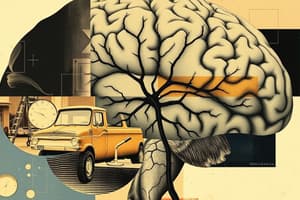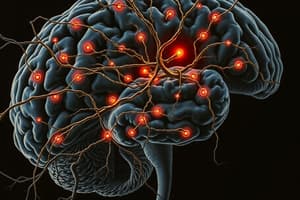Podcast
Questions and Answers
What is the primary function of the spinal cord in the central nervous system?
What is the primary function of the spinal cord in the central nervous system?
- Transmitting information between the brain and the body (correct)
- Controlling thought
- Regulating body temperature
- Interpreting visual stimuli
Which part of the nervous system consists of all the nerves outside of the central nervous system?
Which part of the nervous system consists of all the nerves outside of the central nervous system?
- Olfactory nervous system
- Parietal nervous system
- Spinal nervous system
- Peripheral nervous system (correct)
How many neurons are estimated to be present in the brain?
How many neurons are estimated to be present in the brain?
- 100 billion neurons (correct)
- 50 billion neurons
- 500 million neurons
- 10 million neurons
Which lobe of the brain is primarily responsible for processing sensory information?
Which lobe of the brain is primarily responsible for processing sensory information?
What is the function of the meninges in the brain?
What is the function of the meninges in the brain?
Which part of the nervous system is responsible for controlling movement and emotion?
Which part of the nervous system is responsible for controlling movement and emotion?
Which part of the brain is responsible for controlling involuntary functions like heart rate and blood pressure?
Which part of the brain is responsible for controlling involuntary functions like heart rate and blood pressure?
What is the function of the somatic nervous system?
What is the function of the somatic nervous system?
Which nervous system division is responsible for digestion and blood pressure regulation?
Which nervous system division is responsible for digestion and blood pressure regulation?
What are the finger-like projections on neurons that receive signals called?
What are the finger-like projections on neurons that receive signals called?
Which disorder is characterized by muscle weakness and changes in sensation?
Which disorder is characterized by muscle weakness and changes in sensation?
What is the function of the spinal cord in the nervous system?
What is the function of the spinal cord in the nervous system?
Study Notes
The Nervous System: Structure and Function
The nervous system is a complex network of cells and tissues that allows for communication and coordination between different parts of the body. It consists of the brain and spinal cord, collectively known as the central nervous system (CNS), and all the nerves outside of the CNS, which form the peripheral nervous system (PNS). The nervous system is crucial for various bodily functions, including movement, thought, emotion, and regulation of vital processes such as breathing, heart rate, and body temperature.
Central Nervous System
The central nervous system is composed of the brain and spinal cord. The brain is the most complex organ in the body and is responsible for controlling thought, movement, and emotion. It consists of an estimated 100 billion neurons and is protected by the skull and a triple-layered membrane called the meninges. The spinal cord extends from the brain down the spine and is responsible for transmitting information between the brain and the rest of the body.
Brain Structure and Function
The brain can be divided into four main lobes: temporal, parietal, occipital, and frontal. Each lobe is responsible for specific functions, such as processing sensory information, interpreting visual stimuli, and controlling motor functions. The brain also contains several specialized regions, including the medulla oblongata, hypothalamus, thalamus, and amygdala, which are involved in various processes like regulating heart rate, breathing, and emotional responses.
Spinal Cord Structure and Function
The spinal cord runs from the brain down the spine and is responsible for transmitting sensory information from the body to the brain and relaying motor commands from the brain to the body. It contains circuits that control reflexive responses and can generate complex movements like walking even without input from the brain.
Peripheral Nervous System
The peripheral nervous system is made up of all the nerves outside of the CNS and is further divided into the somatic nervous system and the autonomic nervous system.
Somatic Nervous System
The somatic nervous system is responsible for relaying information from the sensory organs to the CNS and for relaying commands from the CNS to the muscles. It allows for voluntary control of movement and the perception of sensory information from the body.
Autonomic Nervous System
The autonomic nervous system controls involuntary functions like digestion, blood pressure, and heart rate. It is made up of two parts, the sympathetic nervous system and the parasympathetic nervous system, which often work in opposite ways to regulate various bodily functions.
Neurons and Communication
The basic building block of the nervous system is the neuron, or nerve cell. Neurons are shaped differently depending on their location and function. They have finger-like projections called dendrites and an axon, which is often coated by a myelin sheath. Neurons communicate with each other through electrical signals and the release of neurotransmitters at synapses, the spaces between neurons.
Nervous System Disorders
Several disorders can affect the nervous system, including epilepsy, meningitis, multiple sclerosis, Parkinson's disease, sciatica, shingles, and stroke. These conditions can cause a wide range of symptoms, such as seizures, muscle weakness, and changes in sensation. Treatment for these disorders often involves medications, physical therapy, or surgical intervention.
Studying That Suits You
Use AI to generate personalized quizzes and flashcards to suit your learning preferences.
Description
Test your knowledge about the structure and function of the nervous system, including the central nervous system (CNS) composed of the brain and spinal cord, the peripheral nervous system (PNS), neurons and communication, as well as common nervous system disorders. Explore topics such as brain lobes, spinal cord functions, and the roles of the somatic and autonomic nervous systems.




